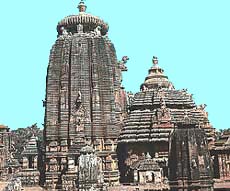|

|
North Indian
Central Indian
East Indian
West Indian
South Indian
Hindu Pilgrimage
|

|
| |
.....Continued

In Hindu cosmology, the centre of the universe is conceived of as a mountain, Meru. From the base of the Mount
Meru, the continents spread out in all directions, with India to the south.
Meru is considered to be the home of Gods, ruled over by Indra. Thus, the sanctuary of an Indian Temple invariably has a tower superstructure placed above the sanctuary; the Sanskrit terms for this tower-element is
'shikara'. The God in the innermost part of the temple is thus placed within a cave like or womb like chamber. The emphasis on water is important and if a river is not available, a tank should be provided. Rites of conservation carried out by Brahmins are listed in the
shastra literature. They include the placing of a foundation deposit prior to commencement of building, right thru to rites for the placement of the final anchoring stone elements which crown the
shikara - these are the ribbed and fruit-like 'amalakas', above which is the final pot shaped finial,
'Kalasha'. These, traditionally, are all necessary elements in the correct constructions of a Temple.
Parts of an Indian temple
The temple is the most significant monument of ancient Indian art and architecture. In order to appreciate the artistic value of the temples, it is necessary to study the principal parts of an Indian temple.
- Garbha Griha (Holy of holies) is the most sacred part of the temple where the main deity, normally carved in stone, is kept. It is a small dark square cell, the doorway of which always faces the east.
- Vimana or Shikara is a tower on the roof of the Garbha Griha.
- Antarala (Vestibule) is a rectangular room between the sanctum and the pillared hall.
- Mandapa is a pillared hall which shelters devotees during the time of worship.
- Ardha Mandapa is a porch between the entrance and the Mandapa.
|




